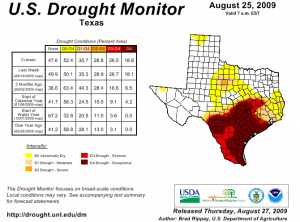I’m in the midst of a story for the newspaper about drought and climate change that looks at the importance of temperature. It is not simply whether more or less rain falls, but also how much evaporation there is. This is the critical message from Richard Seager’s 2007 paper about the permanent Dust Bowl.

Texas conditions from Drought Monitor
That is also the message from this week’s discussion of current conditions in Texas from the Drought Monitor:
Historic drought continued to grip southern Texas, where San Antonio closed in on its driest two-year period on record. From August 1954 – September 1956, San Antonio—entrenched in an area of exceptional drought (D4)—received precipitation totaling 30.23 inches. During the current drought, only 24.78 inches (38 percent of normal) fell from September 1, 2007 – August 25, 2009. In other words, San Antonio would need 5.45 inches of rain during the last six days of August to prevent a record-low, two-year total. In addition, San Antonio’s tally of 100-degree days continued to climb. San Antonio’s former 1998 annual record of 36 days with triple-digit heat was broken long ago; through August 25, there have been 56 days with highs of 100 degrees F or greater. Elsewhere in southern Texas, locations such as Corpus Christi and Victoria endured a 79th consecutive day (June 8 – August 25) with above-normal temperatures.
